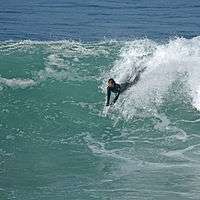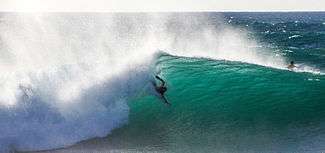Bodysurfing


Bodysurfing is the art and sport of riding a wave without the assistance of any buoyant device such as a surfboard or bodyboard. Bodysurfers usually equip themselves with a pair of specialized swimfins that optimize propulsion and help the bodysurfer catch, ride and kick out of waves.
Technique
To get on the wave, bodysurfers must time their launch, pick a direction, kick and stroke hard with feet and arms, then use their back and outstretched arm, to ride the wave both sideways and downward. Turns can be performed by digging the shoulder into the wave, causing the person to slide to the side of the wave and accelerate. Advanced techniques include spins and barrel rolls.
Exiting the wave is key to safety. The safest exit maneuver is roll sideways into the back of wave until one exits out the back where the wave is no longer breaking. In stronger waves, the same maneuver applies, however the surfer must apply greater force to exit. This must be done with no hesitation, to avoid injury. Some bodysurfers opt to stay inside the hollow part of the wave — commonly known as the barrel — until it closes out onto them.
Contests

The Pipeline Bodysurfing Classic competition runs at the world-famous Banzai Pipeline. This event is considered to be a world-class pro-am competition [1] and yet is also considered one of the truly unique underground surf contests around. Among the bodysurfing population at large, the event is considered the premier event internationally. It is one of the only times a professional bodysurfing competition has exclusive access to the Pipeline's favorable winter waves. The event was last held in 2011 due to difficulties securing the location for exclusive use. The Da Hui Invitational Pipeline Bodysurfing Expression Session was held in March 2014. It consisted of a different format than the Pipeline Bodysurfing Classic and awards were given to riders for Best Wave, Best Tube, Best Wipeout, Best Trick, Top Individual Performance and Top Team Performance.[2]
The World Bodysurfing Championships along with the Pipeline Bodysurfing Classic are the two biggest bodysurfing competitions in the world according to the Encyclopedia of Surfing. It started in 1977, and runs every August in Oceanside, California. Another long-time contest is the Manhattan Beach Bodysurfing Contest as a part of the International Surf Festival held in Manhattan Beach, California. This contest is sponsored by the oldest bodysurfing club in The United States, Gillis Beach Bodysurfing Association. Dating back to 1964, the GBBA formed on the beaches of Playa Del Rey in Los Angeles. Members of GBBA run the bodysurfing contest, but do not participate in the interest of promoting the sport. The contest is a part of the International Surf Festival held late July or the first of August annually. The surf festival is known for its volleyball, lifeguard competition and the bodysurfing contests.
In Mexico, between April and June in Ixtapa-Zihuatanejo, at Las Escolleras beach, a tournament called Torneo Internacional de Bodysurf Las Escolleras occurs where the competitors challenge similar powerful waves.
In addition to the contests above there are numerous other contests in California and Hawaii. Many clubs and contests can be found in France, Brazil, Australia. Both France and Brazil have a series of contests to determine a national champion. In the UK, an annual Bodysurfing competition takes place at Trevaunance Cove, St. Agnes. This open contest is extremely competitive at all ages and requires competitors to enter without wetsuits, fins or any other aids.
Other names
In Hawai’i body surfing is called he’e umauma (sliding with the chest) while surfing with a board is called he’e nalu (literally, wave sliding). In Australia, body surfing is occasionally known as 'body bashing'. Body bashing is colloquial for the rough and tumble of the experience of being dumped by ill chosen waves. In Brazil, bodysurfing is popular beach activity known as 'jacaré', which, literally translated into English, means alligator.
"Whomping" or "body-whomping" is a variant that may or may not be done without fins. Generally practiced at hollow, closed-out shore breaks, instead of a smooth slide across the face of the wave, whomping entails going over the falls with maximum air making out a short ride. In contrast, using the sandbar is essential to a rider's (finless) advantage when bodywhomping.
Bodysurfers
US : Mike "Filo" Arens (Calif.) , Robert Otanez (Calif.) , José Gonzalés (Calif.) , Bill Schildge (Calif.) , Mike Cunningham (Calif.) , Tim Casinelli (Calif.) , David Gochros (Hawaï) , Fred Simpson (Calif.) , Mark Cunningham (Hawaï) , Mike Stewart (Hawaï) , Todd Sells (Hawaï)
Morocco : Youness Fakoiallah , Ilyass Jdioui
Australie : Don MacCredie
Brazil : Henrique Pistilli , Kalani Lattanzi
France : JP Arbouet , O. Dassance , P Grieumard , R. Lassus , V. Chavanelle
In popular culture
In 2011, Woodshed Films[3] released the first full length body surfing documentary, "Come Hell or High Water",[4] by Keith Malloy.
In October 2014, the Honolulu City Council proposed renaming popular bodysurfing destination Sandy Beach Park to President Barack Obama Sandy Beach Park. Located near Hanauma Bay on the east end of the island of Oahu in Hawaii, the beach is known for a large shore break and is popular among bodysurfing enthusiasts, including President Obama. President Obama is known to have bodysurfed at Sandy Beach while living in Honolulu as a child, and has done so as recently as a vacation taken to Hawaii while in office. Due to a lack of public support, the city council's proposal to rename the park was withdrawn around October 7, 2014. However, the council had approved a plaque to be placed at the park commemorating the President's fondness for bodysurfing there.[5]
See also
| Wikimedia Commons has media related to Bodysurfing. |
- Crowd surfing (Body surfing)
References
- ↑ "Archived copy" (PDF). Archived from the original (PDF) on 2016-03-12. Retrieved 2016-06-26.
- ↑ "Archived copy". Archived from the original on 2014-08-10. Retrieved 2014-07-31.
- ↑ http://www.woodshed.com/
- ↑ http://www.woodshed.com/?p=1314
- ↑ http://mobile.reuters.com/article/idUSKCN0HW27W20141007?irpc=932/
- "Secrets of a Kahuna Bodysurfer:A Spiritual Adventure Guide" by Lani E Lowel (1999/2006)
- The Art of Bodysurfing by Robert Gardner (1972)
- Bodysurf by Hugo Verlomme and Laurent Masurel (2002)
- The Art of Wave Riding by Ron Drummond (1931)
- The Encyclopedia of Surfing", 2005, Matt Warshaw, Harcourt Books, ISBN 0-15-100579-6
- Swell Lines Magazine, 2014
- " Plan to name popular Hawaiian beach after Obama is a wash-out" Reuters Online. Reporting by Steve Gorman. October 7, 2014 http://reuters.com/article/idUSKCN0HW27W20141007?irpc=932
External links
- Entry about bodysurfing in the Encyclopedia of Surfing
- World Bodysurfing Championships
- International Surf Festival Los Angeles, CA
- Manhattan Beach
- Torneo Internacional de Bodysurf Las Escolleras (Mexico)
- Hawaii State Bodysurfing Association